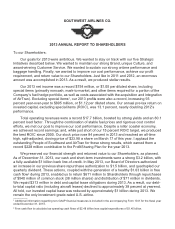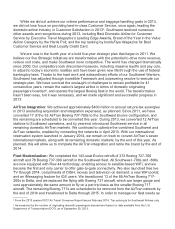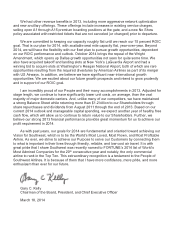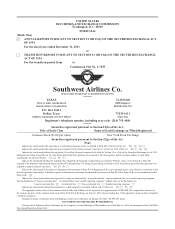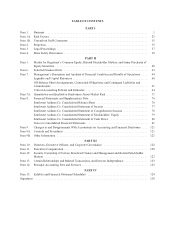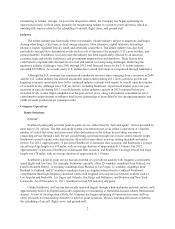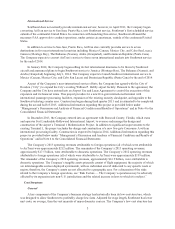Southwest Airlines 2013 Annual Report Download - page 9
Download and view the complete annual report
Please find page 9 of the 2013 Southwest Airlines annual report below. You can navigate through the pages in the report by either clicking on the pages listed below, or by using the keyword search tool below to find specific information within the annual report.PART I
Item 1. Business
Company Overview
Southwest Airlines Co. (the “Company”) operates Southwest Airlines (“Southwest”) and AirTran Airways
(“AirTran”), major passenger airlines that provide scheduled air transportation in the United States and near-
international markets. For the 41st consecutive year, the Company was profitable, earning $754 million in net
income.
Southwest commenced service on June 18, 1971, with three Boeing 737 aircraft serving three Texas cities:
Dallas, Houston, and San Antonio. Including the operations of both Southwest and AirTran, the Company ended
2013 serving 96 destinations in 41 states, the District of Columbia, the Commonwealth of Puerto Rico, and five
near-international countries including Mexico (Cancun, Mexico City, and Cabo San Lucas), Jamaica (Montego
Bay), The Bahamas (Nassau), Aruba (Oranjestad), and Dominican Republic (Punta Cana). At December 31,
2013, Southwest’s and AirTran’s combined active fleet consisted of 680 aircraft, including 614 Boeing 737s and
66 Boeing 717s. The Company reached a major milestone in 2013 by completing the connection of the
Southwest and AirTran networks. Customers can now fly between any of the combined 96 Southwest and
AirTran destinations on a single itinerary.
In 2013, Southwest added service to two new states (Maine and Kansas) and ten new U.S. cities: Branson,
Missouri; Charlotte, North Carolina; Flint, Michigan; Rochester, New York; Portland, Maine; Wichita, Kansas;
Grand Rapids, Michigan; Memphis, Tennessee; Pensacola, Florida; and Richmond, Virginia. The addition of the
new Southwest service establishes a Southwest presence in all domestic cities in Southwest’s and AirTran’s
combined network. In 2013, Southwest also commenced service to San Juan, Puerto Rico, Southwest’s first
scheduled service outside of the continental United States. As part of its network optimization efforts, the
Company has announced its plans to cease Southwest operations in Branson, Missouri; Key West, Florida; and
Jackson, Mississippi beginning in June 2014. Based on the most recent data available from the U.S. Department
of Transportation, as of September 30, 2013, Southwest was the largest domestic air carrier in the United States,
as measured by the number of domestic originating passengers boarded.
During fourth quarter 2013 the Company took steps to supplement its existing service at New York
LaGuardia Airport by acquiring 12 takeoff and landing slots (for six roundtrip flights) at LaGuardia (a “slot” is
the right of an air carrier, pursuant to regulations of the Federal Aviation Administration (“FAA”), to operate a
takeoff or landing at a specific time at certain airports). The acquired slots were divested by AMR Corporation,
the parent company of American Airlines, Inc., as part of its merger with US Airways Group, Inc. Also in
connection with the divestiture, the Company gained ownership through the purchase of ten takeoff and landing
slots (for five roundtrip flights) at LaGuardia that it previously operated under a lease from American. The
Company plans to supplement its existing Southwest service utilizing these newly acquired slots at LaGuardia
beginning in May 2014. In January 2014, the Company was notified of its winning bid to acquire 54 takeoff and
landing slots (for 27 roundtrip flights) at Washington Reagan National Airport, which must be divested in
connection with the merger between American and US Airways. The acquisition of these slots, which is subject
to final approval of the Department of Justice and customary written agreements, will supplement the Company’s
existing service at Washington Reagan.
While AirTran continues to service certain domestic cities and all of the Company’s international markets,
the Company has announced plans to convert AirTran’s remaining domestic and international service into
Southwest service by the end of 2014.
Southwest principally provides point-to-point, rather than hub-and-spoke, service. This has enabled it to
maximize the use of key assets, including aircraft, gates, and Employees, and has also facilitated its ability to
provide its markets with frequent, conveniently timed flights and low fares. Point-to-point service is discussed in
more detail below under “Company Operations — Route Structure.” AirTran has historically provided hub-and-
spoke, rather than point-to-point, service, with approximately half of AirTran’s flights historically originating or
1

